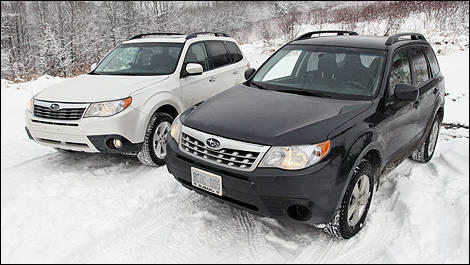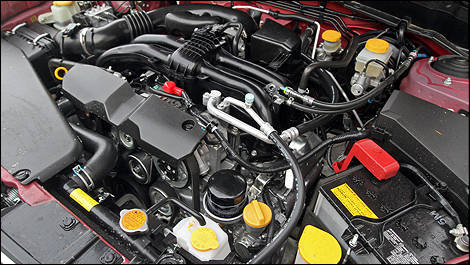Lac-Saint-Joseph, Quebec – The Subaru Forester is a vehicle for serious drivers. I’m thinking of people who are looking for a compact SUV – are real one. Not some exotically shaped machine (like the ZDX), one with visions of versatility that barely manages to accommodate your groceries.
No, these buyers don’t need an eccentric number that strokes their egos at the expense of the real needs of their small family. That’s why you see them driving Foresters, Ford Escapes and Toyota RAV4s. They’re like tall versions of the ever-practical wagon.
How sharp is your eye?
For 2011, Subaru is serving up a Forester benefiting from considerable mechanical improvements hidden beneath a vaguely restyled body. Yes, you have to have a sharp eye to tell the 2011 and 2010 models apart.
Body changes are limited to two things. First, the grille has been lightly updated, purely for aesthetic reasons. Second, the colour palette has been tweaked: three shades have been added, Marine Blue Pearl, Spark Silver Metallic and Paprika Red Pearl, while Newport Blue Pearl and Steel Silver Metallic have been dropped.
However, the most important changes happened under the hood.
A new mill
Though it’s still motivated by a naturally aspirated flat-4, an architecture taken up by Subaru in 1966, it’s a largely redesigned engine that now powers the Forester.
The new iteration of the 2.5-litre Boxer equips the four variants of the Forester 2.5X, Base, Convenience, Touring and Limited. The new engine features new bore/stroke dimensions (it’s almost an oversquare engine, as its bore and stroke have gone from 99.5 x 79.0 mm to 94.0 x 90.0 mm) and a chain-driven double overhead cam replacing the belt driven single overhead cam of the previous engine. Naturally the displacement has increased, from 2,457 to 2,498 cc.
Structural modifications have also been made, which have enabled a more compact combustion chamber that, according to the manufacturer, improves the fuel supply and the quality of combustion.
Several main moving parts, like the pistons (longer stroke) and their connecting rods, have been adapted to reduce friction. We’re talking about a 30% increase over the outgoing engine, an improvement that has a direct impact on fuel consumption.
No, these buyers don’t need an eccentric number that strokes their egos at the expense of the real needs of their small family. That’s why you see them driving Foresters, Ford Escapes and Toyota RAV4s. They’re like tall versions of the ever-practical wagon.
 |
| The 2011 Forester (right) stands out from the 2010 model in grille only. (Photo : Luc Gagné/Auto123.com) |
How sharp is your eye?
For 2011, Subaru is serving up a Forester benefiting from considerable mechanical improvements hidden beneath a vaguely restyled body. Yes, you have to have a sharp eye to tell the 2011 and 2010 models apart.
Body changes are limited to two things. First, the grille has been lightly updated, purely for aesthetic reasons. Second, the colour palette has been tweaked: three shades have been added, Marine Blue Pearl, Spark Silver Metallic and Paprika Red Pearl, while Newport Blue Pearl and Steel Silver Metallic have been dropped.
However, the most important changes happened under the hood.
A new mill
Though it’s still motivated by a naturally aspirated flat-4, an architecture taken up by Subaru in 1966, it’s a largely redesigned engine that now powers the Forester.
The new iteration of the 2.5-litre Boxer equips the four variants of the Forester 2.5X, Base, Convenience, Touring and Limited. The new engine features new bore/stroke dimensions (it’s almost an oversquare engine, as its bore and stroke have gone from 99.5 x 79.0 mm to 94.0 x 90.0 mm) and a chain-driven double overhead cam replacing the belt driven single overhead cam of the previous engine. Naturally the displacement has increased, from 2,457 to 2,498 cc.
Structural modifications have also been made, which have enabled a more compact combustion chamber that, according to the manufacturer, improves the fuel supply and the quality of combustion.
Several main moving parts, like the pistons (longer stroke) and their connecting rods, have been adapted to reduce friction. We’re talking about a 30% increase over the outgoing engine, an improvement that has a direct impact on fuel consumption.
 |
| The big news for 2011 is under the hood. It’s an improved version of the 2.5-litre flat-4. (Photo: Luc Gagné/Auto123.com) |


